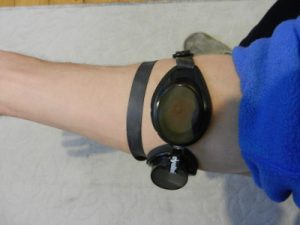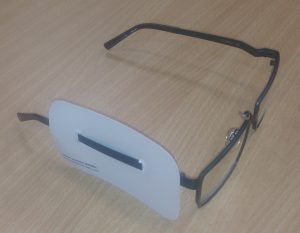Commonly in hotels the room keycard has to be inserted into a slot for the lights in the room to turn on. An annoyance occurs when the lights are reset each time the card is removed and re-inserted, such as when leaving and re-entering the room (this problem and most of the subsequently mentioned ones are based on Courtyard by Marriott Chennai, but some are based on other hotels). Typically all the lights turn on and the unnecessary ones have to be turned off one by one. A simple and cheap microcomputer could remember the on-off settings of the lights and keep these until reset. Another similar problem is that the temperature of the AC or heating, as well as the fan speed, gets reset when the keycard is removed from the slot. Thus the AC has to be readjusted after each re-entry.
The keycard should work consistently, not require several attempts to operate the lift or open the room door.
It is a nice touch for a hotel to have a steam room, sauna or jacuzzi next to the fitness centre, but it would be even better if these were in working order and clean. Another nice touch is to provide slippers in the room, but if these are child-sized, then they are not very useful for an adult male. If there are two pairs of slippers in a room, then different-sized pairs would be reasonable and almost as cheap to provide as same-sized ones.
If (free) wifi is advertised, then it would be nice if it was working. Wifi problems can be detected automatically (by wifi-enabled devices placed in the corners of the hotel remotest from the routers) without waiting for annoyed guests to contact the front desk.
An electric kettle in the room is good for making tea, but placing glasses next to the kettle invites an absent-minded person to pour hot water into these, which cracks them.
The carpet should not shed hair that sticks to socks and anything else it comes into contact with (by floating in the air for example).
The fitness centres in hotels are typically less than 25 square metres. It is possible to choose machines and weights for a small room in such a way that cardio and all major muscle groups can be trained, but hotels seem to choose the machines randomly, e.g. three ellipticals and a stair stepper, but no rowing machine. Or two quadriceps training machines (leg extension and leg press), but no hamstring training machine (prone leg curl). This is despite the fact that quads are easy to train without a machine (do squats with or without weights), but hamstrings difficult.
A common problem in hotels is street noise in the room, which may be expensive to fix if the hotel construction quality is bad. One hotel in which the room was quiet despite a busy street outside was Sheraton New Delhi. A possible reason for its quietness was that the windows had two layers of packet glass, consisting of two or three layers each.
Hotel breakfasts should have a list of ingredients next to each dish, not just the name of the dish, especially when the name is unfamiliar to most visitors, e.g. the name is in the local language for a traditional ethnic dish. The list of ingredients would be especially helpful to people with food allergies, but the non-allergic would also benefit – it is easier to choose with more info. The ingredients in the list should be ordered, starting with the ones that constitute the largest percentage of the dish.
The arrangement of dishes at buffet meals should make it logistically convenient to get food, i.e. movement to and from the dishes should be unrestricted (no closely placed tables blocking the way) and similar foods should be located together. Sometimes hotels make strange food placement choices, for example I have seen soups and meat dishes alternate. Rydges on Swanston in Melbourne placed all the dishes in a small recess off the dining area, so there was a traffic jam of people trying to get into and out of that nook with their plates.
Made-to-order (live cooking) dishes at buffet meals could be prepared and distributed faster if their order system was computerised and the eaters could order the dishes from their smartphones. Peak demand time can be predicted and the cooking started in advance to speed up the delivery of the dishes. Such just-in-time production has economies of scale, so is especially easy for larger buffets.
The hotel room logistics are often strange, e.g. a narrow corridor leading from the door to the room, with wardrobes built into the side of the corridor. The doors of said wardrobes open outward, blocking the corridor. On the other hand, in the Chennai Marriott bathroom the shower stall and the the toilet were behind the same sliding door. To access the toilet, the door had to slide in front of the shower, and to access the shower, the door closed off the toilet. This would be annoying if two or more people stayed in that suite and tried to use the shower and toilet simultaneously, because both could not be behind a closed door at the same time.
Another logistical problem in both hotels and apartments is a toilet door that opens inward. When the toilet is small, the door almost hits the pot, making it difficult to maneuver around the door for entry and exit. Some toilets are so tiny that when sitting on the pot, the knees touch the opposite wall. In this case, it would be better to place the pot diagonally so the knees fit in a corner.
Two doors at the ends of a short corridor that both open into the corridor are impossible to open at the same time, which lengthens the time of passing through both doors.
Some hotels want to show how modern they are by replacing light switches with small touchscreens with LED backlighting. The little LED lights are numerous enough to somewhat light up the room when the ceiling and other lights are turned off. For sleeping, it would be good to be able to turn off the LED lights of the touchscreens.
If a motion detector turns on the light, then being able to switch off the motion detector and the light would be preferable. Sometimes the light is unnecessary, such as during the day with curtains open. The sudden bright light may also be annoying, for example when visiting the bathroom at night.
Hotel beds are usually short, so people over 180cm have their feet over the edge, unless they lie diagonally. Luckily hotel beds are usually wide, so their diagonal is significantly longer than the long side.

